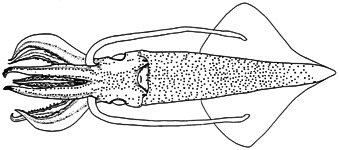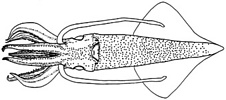Watasenia
Watasenia scintillans
Kotaro TsuchiyaIntroduction
W. scintillans occurs only in the waters around Japan. It is a member of the mesopelagic boundary fauna in these waters and is fished commercially with set nets.Characteristics
From Young, et al., 1998.
- Arms
- Suckers absent from Arms IV (hooks present).*
- Tentacles
- Manus of club with hooks in one series (2-3 in number) and one series of suckers.
- Hectocotylus
- Right ventral arm of male hectocotylized.
- Hectocotylus with two subequal-sized offset flaps.
- Buccal crown
- Dark epithelial pigmentation on oral surface rather than typical chromatophores.*
- Photophores
- Two to four large organs covered by black chromatophores on tips of arms IV.*
- Five organs on eyeball.*
- Complex organs of integument, in life, probably with red-colored filters.*
Distribution
Vertical distribution
Spawned eggs are mainly collected from the surface to 80 m depth.Geographical distribution
W. scintllans seems to be amesopelagic boundary species associated with shelf waters.This species shows high endemism in the waters of Japan and adjacent areas. It is distributed in the northern sector of the East China Sea and the Kii Channel, Central Japan, northward to Japan Sea, Okhotsk Sea, southeast coast of Honshu, transition zone off Sanriku District to 165° E, and the southeast coast of Hokkaido.
Life History
Eggs and Egg masses
The eggs of W. scintillans is ovoidal, 1.5 mm L x 1 mm D, transparent, no coloration but with weak luster reflection. The adult female has several hundred to 20,000 mature eggs in its oviducts.The egg mass is narrow gelatinous string more than 1 m with a simple row of eggs.
Spawning
In Toyama Bay, middle of the Japan Sea, eggs occurred in the plankton in February - July and November - December. In the offshore area of Shimane Prefecture, western Japan Sea, eggs were found throughout the year except for December and January. The peak of egg occurrence is April to late May.Spawning grounds in Japan Sea were recognized at the shelf edge in east and west of Oki Island and Toyama Bay. Some spawnings were recognized on Yamato-tai Bank.
Spent females were also collected from the open ocean off Sanriku, the Kuroshio-Oyashio transition zone.
Early development
Fertilazed eggs hatch in 14 days at 9.7 °C, 8 days at 13.4 °C and 6 days at 16 °C water tempelature. Lower limit for normal development seems to be at 6 °C (Hayashi, 19**).At 15 C water temperature:
- 1 hr after fertilized: Polar bodies appear.
- 6 hrs: First cleavage.
- ca. 10 hrs: 100 and more cells.
- ca. 16 hrs: Embryonic lobe developed.
- ca. 1.5 day: Embryonic lobe covers about half of the egg.
- ca. 4 days: Primordial eye appears; oral depression start.
- ca. 5 days: Primordial arms, mantle, funnel appear; chromatophore appears on mantle; funnel lobe fused to tube; eye developed.
- ca. 8-8.5 days: Hatching; chromatophores appear on head, arm; ink inject in inksac; gill, branchial heart, liver appear.
Predators
This species is an important food items for bottom fishes and large salmonid fishes in the coastal waters of northern Japan (Yamamura, 1993).Fisheries Interest
W. scintillans is fished commercially in Japan. Total catches in Japan during 1990-1999 are 4,804 to 6,822 tons per year.In the Toyama Bay, central Japan Sea, squid are cought by fixed net during March to June (the main fishing period is mid-April to early May). The average catch per year is 2,000 tons (250 million individuals) but the catch is variable in each year around from 500 to 4,000 tons.
In the southwestern coast of Japan Sea, squid are caught by bottom trawl. The amount of the catch during 1990-1999 was 1,873 to 3,638 tons per year.
References
Hayashi, S. 2000.
Segawa, S. 2000.
Yamamura, O. 1993.
Young, R. E., L. A. Burgess, C. F. E. Roper, M. J. Sweeney and S. J. Stephen. 1998. Classification of the Enoploteuthidae, Pyroteuthidae and Ancistrocheiridae. Smithson. Contr. Zool., No. 586: 239-255.
Title Illustrations
| Scientific Name | Watasenia scintillans |
|---|---|
| Copyright | © Richard E. Young |
About This Page
Tokyo University of Fisheries, Konan, Minato, Tokyo
Page copyright © 2000
Citing this page:
Tsuchiya, Kotaro. 2000. Watasenia . Watasenia scintillans. Version 01 January 2000 (under construction). http://tolweb.org/Watasenia_scintillans/19645/2000.01.01 in The Tree of Life Web Project, http://tolweb.org/











